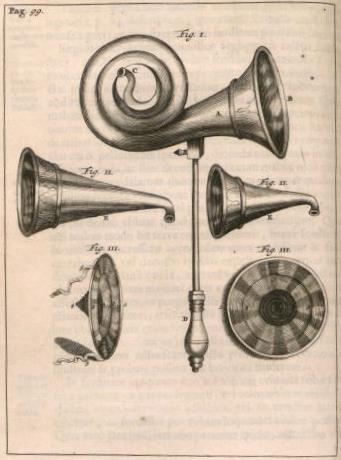
We might take it for granted that our hearing aids are barely visible, can be managed with our smartphones, and can differentiate between speech and background sound. What we may not recognize, however, is that those capabilities are the products of 400 years of research, design, and development.
Even 5 years ago, hearing aids could not deliver the clarity of sound generated at present. To see why, let’s trace the history of hearing aids—starting today and travelling backwards—to observe how hearing aids would have handled your hearing loss in four different years: 2016, 1985, 1940, and 1650.
2016 – Modern Day Digital Hearing Aids
It’s 2016 and you’re looking to treat your hearing loss. You launch an internet browser, search for a nearby hearing care provider, complete a brief form, and schedule a consultation.
At your hearing exam, your hearing is examined using advanced computer technology that accurately assesses your hearing. Then, with the assistance of your hearing professional, you decide on a hearing aid that satisfies your needs from a vast range of models.
Then, your hearing professional programs your new hearing aids to magnify only the sounds and frequencies you have difficulty hearing, leading to crystal clear sound without distortion.
If you were to tell anyone in the 1980’s that this would be the process, they wouldn’t have thought it was possible.
So what did render it possible? In short, digital technology.
For the majority of their history, there was no way for hearing aids to differentiate between different sound frequencies. Hearing aids would amplify all inbound sound, including background noise, producing distorted sound.
The digital revolution addressed that issue. With digital technology, all information can be changed, saved, and manipulated as combinations of 0’s and 1’s. Digital technology enabled hearing aids to transform sound frequencies into digital information, which could then be labeled according to which sounds should be amplified (speech) and which should be restrained (background noise).
The first all-digital hearing aid was created in 1995, and since then the technology has improved significantly, eventually to include wireless capability.
1985 – Transistor Hearing Aids
Now, imagine it’s 1985 and you’re seeking to treat your hearing loss. You can forget searching for a local hearing care provider on the web because the first commercial internet service provider won’t be established until 1989.
You would have to use the yellow pages, depend on referrals, or drive around the neighborhood to find a hearing care practice.
After booking a consultation and having your hearing evaluated, your choices for hearing aids are very restricted. With no microprocessor and digital technology, hearing aids were constructed with a collection of transistors. This adds size and increased power requirements, resulting in bigger batteries and larger hearing aids.
Additionally, without the advantage of digital technology, the hearing aid can’t differentiate between various frequencies of sound. Hearing aids receive incoming sound and the transistors function as simple amplifiers, amplifying all sound. So if you’re in a noisy area, speech recognition will be nearly impossible.
1940 – Vacuum Tube Hearing Aids
It’s 1940 and you’re looking into acquiring a hearing aid. Transistors haven’t been applied to hearing aids yet, so your options are restricted to vacuum tube hearing aids.
Vacuum tubes consume more power than transistors, so the hearing aids call for larger batteries, making the hearing aids big, heavy, and cumbersome.
And once again, without digital technology, the hearing aids can only act as basic amplification systems, making all incoming sound louder. The hearing aids can’t enrich speech and cannot remove background noise.
1650 – Ear Trumpets
Let’s travel all the way back to 1650. There’s no digital technology, no transistors, and no vacuum tubes. As a result, there is no way to convert sound into electrical currents that can be amplified.
With electrical amplification unattainable, your only alternative is mechanical amplification by concentrating and compressing sound into the ear canal, like what takes place when you cup your hands around your ears.
By 1650, gadgets were developed that focused incoming sound into the ears, and these devices were named ear trumpets. They were large gadgets with a conical end that picked up sound and a narrow end that concentrated the sound into the ear.
This would be the only technology readily available to individuals with hearing loss for the following 250 plus years.
Let’s return to 2016. Over more than 400 years of history, hearing aids have evolved from mechanical amplification devices to electrical amplification devices, from vacuum-tube-based to digital-based. They’ve become progressively more compact, lighter, and more effective and affordable.
They’ve also become better at differentiating between different types of sound, and in amplifying only specific kinds of sound (like amplifying speech while repressing background noise).
Every generation of hearing aid has generated a major enhancement over the previous generation. The question is, what’s the next major milestone in the history of hearing aids?
Will we eventually be able to enhance natural human hearing, rather than merely restore it?